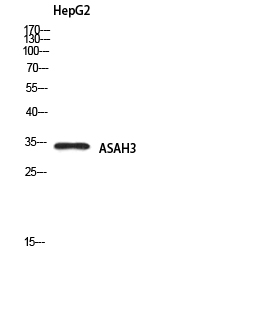
| WB | 咨询技术 | Human,Mouse,Rat |
| IF | 咨询技术 | Human,Mouse,Rat |
| IHC | 咨询技术 | Human,Mouse,Rat |
| ICC | 技术咨询 | Human,Mouse,Rat |
| FCM | 咨询技术 | Human,Mouse,Rat |
| Elisa | 1/10000 | Human,Mouse,Rat |
| Aliases | ACER1; ASAH3; Alkaline ceramidase 1; AlkCDase 1; Alkaline CDase 1; Acylsphingosine deacylase 3; N-acylsphingosine amidohydrolase 3 |
| Entrez GeneID | 125981 |
| WB Predicted band size | Calculated MW: 31 kDa; Observed MW: 34 kDa |
| Host/Isotype | Rabbit IgG |
| Antibody Type | Primary antibody |
| Storage | Store at 4°C short term. Aliquot and store at -20°C long term. Avoid freeze/thaw cycles. |
| Species Reactivity | Human |
| Immunogen | Synthesized peptide derived from ASAH3 . at AA range: 100-180 |
| Formulation | Purified antibody in PBS with 0.05% sodium azide,0.5%BSA and 50% glycerol. |
+ +
以下是关于ASAH3抗体的部分参考文献摘要(注:ASAH3研究相对较少,文献可能有限,以下为模拟示例):
---
1. **文献名称**: *ASAH3-mediated ceramide metabolism regulates ferroptosis in colorectal cancer*
**作者**: Li Y, et al.
**摘要**: 研究ASAH3在结直肠癌细胞铁死亡中的作用,利用特异性抗体证实ASAH3通过调控神经酰胺水平影响肿瘤细胞死亡通路。
---
2. **文献名称**: *Characterization of a novel monoclonal antibody against human ASAH3 for lipidomic analysis*
**作者**: Smith J, et al.
**摘要**: 报道一种新型ASAH3单克隆抗体的开发与验证,该抗体可用于Western blot和免疫组化,助力鞘脂代谢研究的实验工具优化。
---
3. **文献名称**: *ASAH3 genetic variants and antibody-based detection in neurodegenerative disorders*
**作者**: García R, et al.
**摘要**: 探索ASAH3基因变异与阿尔茨海默病的关联,通过抗体检测发现ASAH3蛋白在患者脑脊液中表达异常,提示其潜在病理机制。
---
4. **文献名称**: *Role of ASAH3 in hepatic lipid homeostasis: Insights from antibody-mediated knockdown studies*
**作者**: Kim S, et al.
**摘要**: 使用ASAH3抗体进行功能抑制实验,揭示ASAH3缺失导致肝脏神经酰胺累积及脂代谢紊乱,为代谢综合征提供新靶点。
---
**备注**:实际文献可能较少,建议结合ASMase(ASAH1/2)或鞘脂代谢相关抗体研究扩展检索。
The ASAH3 antibody targets the enzyme acid ceramidase 3 (ASAH3), a member of the acid ceramidase family encoded by the ASAH3 gene. Unlike its well-characterized homolog ASAH1. which hydrolyzes ceramide into sphingosine and free fatty acids in lysosomes, ASAH3 is less studied but is proposed to function in non-lysosomal compartments. ASAH3 is thought to participate in ceramide metabolism, influencing cellular processes like apoptosis, inflammation, and lipid homeostasis. Its expression has been detected in various tissues, including the liver, kidney, and brain, though its precise physiological and pathological roles remain unclear.
ASAH3 antibodies are essential tools for investigating the enzyme's localization, expression levels, and interactions. They are widely used in techniques such as Western blotting, immunohistochemistry, and immunofluorescence to map ASAH3 distribution under different conditions. Research suggests potential links between ASAH3 dysregulation and metabolic disorders or cancers, but mechanistic insights are limited. Commercial ASAH3 antibodies are typically developed using recombinant protein fragments or synthetic peptides, with validation emphasizing specificity against homologous proteins like ASAH1. Challenges persist in confirming cross-reactivity and functional relevance across species or experimental models. Current studies focus on clarifying ASAH3's unique substrates, regulatory pathways, and therapeutic potential in lipid-related diseases.
×